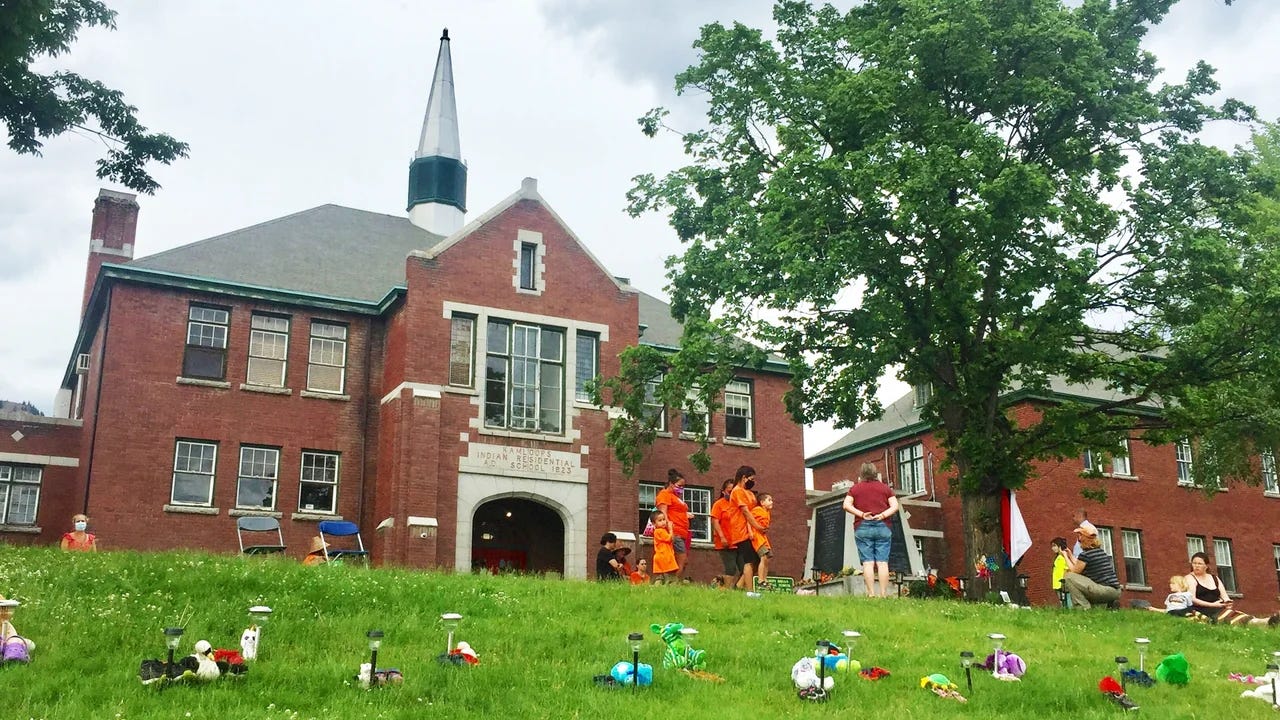
Today happens to be the second anniversary of what I have called Canada’s “day which will live in infamy,” namely the day the following shocking announcement was heard around the world.
Tk̓emlúps te Secwépemc (Kamloops Indian Band)
OFFICE OF THE CHIEF
May 27, 2021, Kamloops – It is with a heavy heart that Tk’emlúps te Secwé pemc Kukpi7 (Chief) Rosanne Casimir confirms an unthinkable loss that was spoken about but never documented by the Kamloops Indian Residential School. This past weekend, with the help of a ground penetrating radar [GPR] specialist, the stark truth of the preliminary findings came to light – the confirmation of the remains of 215 children who were students of the Kamloops Indian Residential School.
“We had a knowing in our community that we were able to verify. To our knowledge, these missing children are undocumented deaths,” stated Kukpi7 Rosanne Casimir. “Some were as young as three years old. We sought out a way to confirm that knowing out of deepest respect and love for those lost children and their families, understanding that Tk’emlúps te Secwé pemc is the final resting place of these children.
Tk’emlúps te Secwé pemc expect to complete preliminary findings by mid-June and will be providing updates as they become available.
Unlike America’s “day which will live in infamy,” December 7, 1941, the day the Empire of Japan attacked United States military bases at the Pearl Harbor, Hawaii, and the Philippines, and declared war on the United States and the British Empire, an event producing countless volumes of carefully documented government and other evidence, no real “updates” have ever been provided about Kamloops and we don’t know any more — from an objective Western scientific perspective as opposed to an emotional pre-scientific indigenous truth-telling perspective — than we knew on May 27, 2021, which means almost nothing more than what is contained in this press release.
This is because GPR reveals only soil disturbances of unknown provenance and is most effective in determining the presence and placement of graves in known and named cemeteries.
The Kamloops band’s silence on doing any conclusive study of the alleged burials is deafening.
The Canadian government’s indifference to this deafening silence is politically and morally unconscionable.
Some readers may be among the 226,000 people — yes, two hundred and twenty-six thousand — who have already read the groundbreaking piece about Kamloops written by Jacques Rouillard, professor emeritus, Department of History, Université de Montréal, much of it rooted in the outstanding historical research and analysis carried out by independent researcher Nina Green who is the creator and editor of the comprehensive and unbiased Wordpress website titled Indian Residential School Records.
If you haven’t read this piece before, you missed bombshell revelations that are slowly but surely becoming common knowledge among curious or skeptical Canadians.
More than any other publication about Canada’s Indian Residential Schools, a noble — albeit flawed — education enterprise meant to allow indigenous children to learn the skills necessary to participate in and benefit from the modernization of the new country of Canada, Rouillard’s essay raised awareness that much that has been proclaimed and accepted as gospel truth in recent years, especially the “discovery” of the remains of 215 children next to the former Kamloops IRS in British Columbia, are exaggerations, distortions, or outright fabrications.
That’s why I’ve saved this piece, first published in a prestigious national journal on January 11, 2022, for today, the second anniversary of the Kamloops Indian Band’s press release, now increasingly believed to be fake news.
I invite you to read Professor Rouillard’s outstanding exposé, reproduced in its entirely on the other side of the paywall with his kind permission, to find out why.
Whether they wish to access this essay or not, readers need to ask themselves a fundamental question: why has no attempt been made by Kamloops band officials and residents to demand use of minimally invasive techniques at the school site to quickly, safely, respectfully, and conclusively determine the contents of even a single currently inconclusive radar hit while their counterparts — indigenous family members, political leaders, activists, and members of the mainstream media — have been loudly demanding for the search of the four-acre Prairie Green private landfill on the outskirts of Winnipeg for months.
That’s the site where the bodies of Morgan Harris, 39, and Marcedes Myran, 26, two missing indigenous women, are suspected to have been buried in mid-2022, both the presumed victims of the same attacker, a three-year possibly $184 million effort that would present substantial risks for potential searchers given the hazardous materials in that location.
Could the answer be that Kamloops officials know full well that these GPR-detected soil disturbances don’t represent the presence of any human remains while their Winnipeg counterparts expect they will have much to gain apart from emotional closure from the Winnipeg search?
And could that be why Kamloops Band officials are not commemorating the second anniversary of this so-called discovery, at least according to the community’s website, as they did for the first anniversary last year?
By the way, I have also memorialized this anniversary with an update essay of my own that was also published today by a national news site. I’ll re-post it here in due course.
Keep reading with a 7-day free trial
Subscribe to REAL Indigenous Report to keep reading this post and get 7 days of free access to the full post archives.



